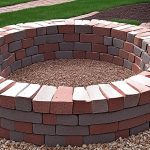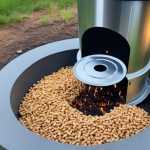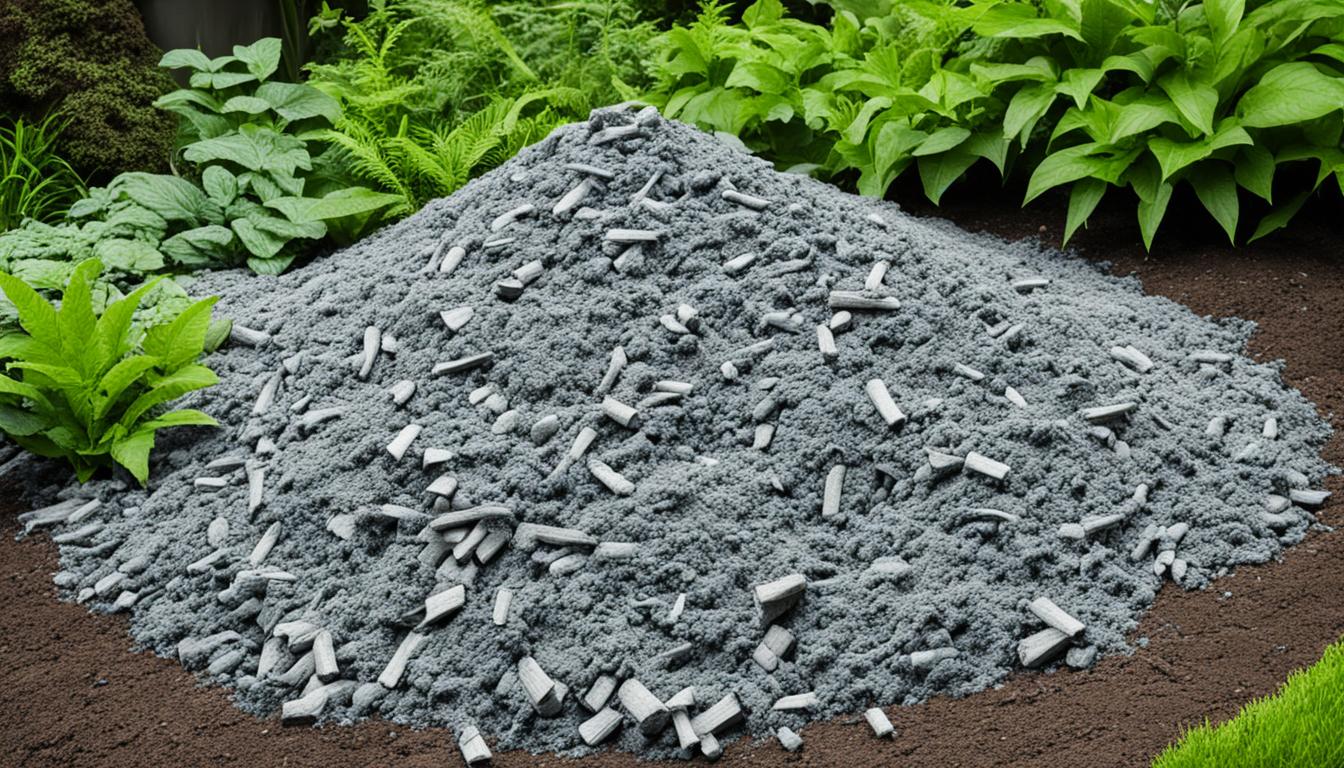“Nature is not a place to visit. It is home.”
– Gary Snyder
Discover the hidden potential of wood ash and how it can revolutionize your home and garden. This humble byproduct of fire holds a plethora of creative and practical uses that can enhance your living spaces, nurture your plants, and contribute to a sustainable lifestyle.
Key Takeaways:
- Wood ash can be used as a natural fertilizer, providing essential nutrients for plant growth.
- By incorporating wood ash into your compost, you can create nutrient-rich soil amendments for your garden.
- Wood ash has abrasive properties, allowing it to serve as an effective eco-friendly cleaning agent.
- Explore the culinary uses of wood ash, such as ash-roasting and ash-infused ingredients, to add unique flavors to your dishes.
- Utilize wood ash as a natural pest deterrent to protect your garden from common pests and insects.
Wood Ash as an Effective Fertilizer for Plants
Discover the power of wood ash as a natural fertilizer for your plants and unlock their full growth potential. By incorporating wood ash into your garden care routine, you can nourish your vegetables, promote flowering, and enhance overall plant health.
When using wood ash as a fertilizer, it’s important to follow the correct application methods and ratios to ensure optimal results. Here are some tips on how to use wood ash in your garden:
- Mix wood ash with compost or well-rotted manure to create a nutrient-rich soil amendment.
- Apply wood ash sparingly around the base of your plants, avoiding direct contact with stems or foliage.
- Spread the wood ash evenly over the soil surface and gently incorporate it into the top layer.
- Water your plants thoroughly after applying wood ash to prevent any potential burning.
- Monitor the pH levels of your soil, as wood ash is alkaline and can raise the pH. Adjust the amount of wood ash accordingly to maintain optimal pH levels for your specific plants.
Wood ash contains essential nutrients such as potassium, calcium, and magnesium, which are beneficial for plant growth. These nutrients contribute to root development, flower production, and overall plant vigor.
However, it’s crucial not to overuse wood ash as a fertilizer. Excessive application can lead to nutrient imbalances and pH disruptions in the soil. Regular soil testing will help you determine the appropriate amount of wood ash to use for your specific garden needs.
As a natural and organic fertilizer, wood ash is a sustainable and eco-friendly option for plant care. By utilizing this readily available resource, you can enhance the health and vitality of your garden while reducing reliance on synthetic fertilizers.
So why wait? Start harnessing the benefits of wood ash as a fertilizer today and watch your plants thrive!
Wood Ash Fertilizer Benefits
| Benefits of Wood Ash as a Fertilizer |
|---|
| Provides essential nutrients such as potassium, calcium, and magnesium |
| Promotes root development and flowering |
| Improves overall plant health and vigor |
| Serves as a sustainable and eco-friendly fertilizer option |
Wood ash fertilizer is an effective and natural solution for promoting plant growth and maximizing the productivity of your garden. Its nutrient content and eco-friendly nature make it a valuable addition to any gardening routine.
Enhancing Compost with Wood Ash
Wood ash can be a valuable addition to your composting efforts, providing essential nutrients and helping to balance the pH levels of your compost. By incorporating wood ash into your compost pile or bin, you can create nutrient-rich soil amendments that will enhance the health and vitality of your garden.
When using wood ash in compost, it’s important to find the perfect ratio of ash to organic matter to achieve optimal results. A general guideline is to add no more than 10-15% wood ash by volume to your compost mixture. This ensures a balanced mixture that won’t disrupt the decomposition process or create an overly alkaline environment.
Wood ash is particularly beneficial for composting because it contains essential nutrients such as potassium, phosphorus, and calcium. These nutrients are necessary for healthy plant growth and can contribute to increased yields and improved soil fertility.
In addition to providing essential minerals, wood ash can also help balance the pH levels of your compost. Most organic materials used in composting tend to be slightly acidic, and the alkaline nature of wood ash can counteract this acidity, creating a more neutral pH that supports the growth of beneficial microorganisms.
When incorporating wood ash into your compost, it’s essential to avoid using ash from treated or painted wood. These types of wood may contain harmful chemicals or heavy metals that can be detrimental to your garden and the environment. Stick to using wood ash from clean, untreated sources to ensure the safety and quality of your compost.
By adding wood ash to your composting routine, you can create nutrient-rich soil amendments that promote healthy plant growth and improve overall soil quality. Experiment with different ratios and observe how your plants respond to find the perfect balance for your composting needs.
Benefits of Using Wood Ash in Compost:
- Provides essential nutrients such as potassium, phosphorus, and calcium
- Helps balance the pH levels of compost and create a more neutral environment
- Contributes to increased yields and improved soil fertility
- Supports the growth of beneficial microorganisms
Wood ash is a game-changer when it comes to composting. Its nutrient-rich composition and pH-balancing properties make it a valuable asset for gardeners. Add wood ash to your compost and watch your plants thrive.
Wood Ash for Eco-Friendly Cleaning
Did you know that wood ash can be a powerful and eco-friendly cleaning solution for various surfaces in your home? Not only does it have abrasive properties that help remove stubborn stains, but it can also naturally eliminate odors and grease. Say goodbye to harsh chemical cleaners and embrace the sustainable cleaning power of wood ash.
When using wood ash as a cleaning agent, it’s important to remember a few key tips:
- Always use wood ash from clean, untreated wood sources.
- Allow the wood ash to cool down completely before using it.
- Test a small, inconspicuous area first to ensure compatibility with the surface.
- Wear gloves to protect your hands.
- Remember to rinse the surface thoroughly after cleaning.
Now, let’s explore some specific applications of wood ash for eco-friendly cleaning:
Wood Ash for Glass Cleaning
If you’re tired of streaked and smudged windows, wood ash can be your secret weapon. Its fine particles act as a gentle abrasive, making it ideal for cleaning glass surfaces without leaving scratches. Simply sprinkle a small amount of wood ash onto a damp cloth or sponge, and gently rub the glass in circular motions. Rinse with water and admire the streak-free shine.
Wood Ash for Silverware Polishing
Bring back the luster to your tarnished silverware using wood ash. Create a paste by mixing wood ash with a small amount of water. Apply the paste onto a soft cloth and rub it onto the silverware in a gentle, circular motion. Rinse thoroughly and dry with a clean cloth to reveal the renewed brilliance of your silverware.
Wood Ash for Surface Scrubbing
Wood ash’s abrasive nature makes it an excellent choice for scrubbing dirty surfaces. From countertops to stovetops, sprinkle a small amount of wood ash onto a damp cloth or sponge, and scrub away grime and stains. Its gentle yet effective cleaning action is perfect for removing grease buildup without damaging the surface.
Wood ash is a versatile cleaning solution that can be used throughout your home. Its natural properties make it an ideal choice for those looking to reduce their environmental impact while maintaining a clean and tidy living space. Embrace the power of wood ash and discover a more sustainable approach to cleaning.
| Surface | Cleaning Method |
|---|---|
| Glass | Sprinkle wood ash onto a damp cloth or sponge, and gently rub on the glass in circular motions. Rinse with water. |
| Silverware | Create a paste with wood ash and water. Apply to silverware, rub gently in circular motions, rinse, and dry. |
| Countertops, Stovetops, etc. | Sprinkle wood ash onto a damp cloth or sponge, and scrub the surface in circular motions. Rinse thoroughly. |
Wood Ash in Cooking and Baking
When it comes to culinary experimentation, wood ash can be a surprising secret ingredient that adds a unique twist to your dishes. Not only does it impart a smoky flavor reminiscent of outdoor cooking, but it also provides added nutritional value to your meals. Let’s explore some creative uses for wood ash in the kitchen.
Ash-Roasting Techniques
Achieve a delectable smoky flavor by incorporating ash-roasting techniques into your cooking process.
- Roast vegetables such as potatoes, carrots, and corn by wrapping them in foil with a sprinkle of wood ash and a dash of olive oil. Place the foil-wrapped vegetables directly onto hot coals or into a preheated oven for a deliciously charred and smoky taste.
- Create mouthwatering ash-roasted meats by marinating them with your favorite seasonings, then encrusting them with a thin layer of wood ash. Cook the meat over an open flame or in a hot oven to lock in the flavors and impart a unique smokiness.
Ash-Infused Ingredients
Discover how ash-infused ingredients can elevate the flavors of your recipes.
Infusing liquids such as cream, milk, or oils with wood ash can lend a distinct smokiness to your sauces, soups, or dressings. Simply combine the ash with the liquid and let it steep for a period of time to impart its flavor. Remember to strain out the ash before using the infused liquid in your cooking.
Unique Recipes with Wood Ash
Expand your culinary horizons by trying out some unique recipes that incorporate wood ash.
One example is the Scandinavian delicacy known as “ash cakes” or “lakkakor”. These traditional Swedish cookies are made with wood ash, giving them a distinctive black color and a hint of smokiness. They are often enjoyed with coffee or tea as a delightfully unexpected treat.
If you’re feeling adventurous, you can also explore the world of ash-cooked cuisine, such as ash-baked bread. This ancient cooking method involves burying the dough in hot wood ash and leaving it to bake slowly, resulting in a crusty exterior and a moist, flavorful interior.

| Recipe | Description |
|---|---|
| Ash-Roasted Vegetables | Seasonal vegetables roasted in foil with a sprinkle of wood ash for a smoky twist. |
| Ash-Marinated Grilled Chicken | Chicken marinated with spices and encrusted with wood ash, then grilled to perfection. |
| Ash-Infused Cream | Cream steeped with wood ash to infuse a smoky flavor for savory sauces. |
| Swedish Ash Cakes | Traditional Swedish cookies made with wood ash, perfect for a unique treat. |
| Ash-Baked Bread | Bread dough buried in hot wood ash to create a crusty and flavorful loaf. |
Immerse yourself in the captivating world of cooking with wood ash. By incorporating ash-roasting techniques, ash-infused ingredients, and trying out unique recipes, you can bring a delightful smoky twist to your culinary creations.
Pest Control with Wood Ash
Wood ash can be an effective and natural pest deterrent for your garden, providing a chemical-free solution to keep unwanted critters at bay. By creating a protective barrier around your plants, you can effectively repel pests like slugs, snails, and other garden pests, safeguarding your beloved greens.
How to Use Wood Ash for Pest Control
Creating a wood ash barrier is simple and straightforward. Follow these steps to keep pests away from your plants:
- Collect sufficient wood ash from your fireplace or wood-burning stove.
- Sprinkle a generous amount of wood ash in a wide circle around the base of your plants.
- Ensure the wood ash forms a continuous line, creating a barrier that pests find difficult to cross.
- Reapply the wood ash every few weeks or after rainfall to maintain its effectiveness.
By using wood ash as a natural pest control measure, you can avoid the need for harmful chemicals that could harm both the environment and your plants.
“Wood ash is a fantastic and eco-friendly way to control pests in the garden. Not only does it repel slugs, snails, and other unwanted visitors, but it also adds valuable nutrients to the soil, benefiting the overall health of your plants.” – Emily Green Thumb, Expert Gardener
The Benefits of Wood Ash as a Natural Pest Deterrent
Why choose wood ash for pest control? Here are some key benefits:
- Eco-friendly: Wood ash is a natural and sustainable option for pest control, minimizing the environmental impact compared to chemical-based alternatives.
- Nutrient-rich: In addition to repelling pests, wood ash also adds valuable nutrients like potassium and calcium to the soil, promoting plant growth and overall health.
- Cost-effective: Utilizing wood ash as a pest deterrent allows you to repurpose a waste product from your fireplace or wood-burning stove, saving money on additional pest control measures.
By harnessing the power of wood ash, you can create a pest-free garden without compromising the health and well-being of your plants or the environment.
| Pest | Effectiveness of Wood Ash |
|---|---|
| Slugs and snails | Repels and creates a physical barrier that slugs and snails find difficult to cross. |
| Caterpillars | May deter certain types of caterpillars, but additional pest control methods may be necessary for effective caterpillar management. |
| Earwigs | Repels and creates an inhospitable environment for earwigs, preventing damage to plants. |
| Aphids | While wood ash is not as effective against aphids, it can help deter them by creating an unfavorable environment. |
Keep in mind that wood ash should be used as part of an integrated pest management approach, combining other strategies such as companion planting, proper watering, and regular plant inspections to maintain a healthy garden.
Wood ash can be an invaluable tool in your arsenal of natural pest control methods. By utilizing this readily available resource, you can protect your plants from pesky invaders while maintaining a healthy and eco-friendly garden.
Wood Ash for Odor Control
Uncover the odor-absorbing properties of wood ash and how it can be used to neutralize unpleasant smells in your home.
Wood ash, a natural and affordable solution, can effectively combat refrigerator and garbage odors, as well as freshen up pet areas.
When placed in a small bowl or container, wood ash acts as a powerful odor absorber, drawing in and neutralizing unwanted smells. Simply leave the container in the area where odors persist, and let the wood ash work its magic.

Wood ash is particularly effective in absorbing odors due to its alkaline nature, which helps to neutralize acidic compounds that can cause unpleasant smells.
Not only does wood ash offer a natural solution for odors, but it also adds a rustic and earthy touch to your home decor. Consider using decorative containers or jars to hold the wood ash, creating a visually appealing and functional addition to any room.
So, instead of relying on chemical-based air fresheners or deodorizers, harness the power of wood ash to eliminate odors in a natural, sustainable, and cost-effective way.
Incorporating Wood Ash into DIY Projects
Take your creativity to new heights by incorporating wood ash into various DIY projects around your home. This versatile ingredient can add unique and earthy elements to your homemade creations, making them truly special.
Homemade Soap and Candles
With wood ash, you can create your own natural and eco-friendly soap and candles. The ash adds texture, color, and a smoky aroma, giving your creations a rustic charm. Combine wood ash with other ingredients such as essential oils, beeswax, and vegetable oils to form delightful scents and soothing textures.
Natural Dyes and Pigments
Transform your plain fabrics, papers, and even raw wood into pieces of art by using wood ash as a natural dye or pigment. The ash can produce a range of earthy hues, from subtle grays to warm browns. Experiment with different application techniques like dye baths, natural pigment painting, or even tie-dyeing to achieve a variety of captivating effects.
Wood Ash Fireplace Logs
Add a touch of nostalgia and warmth to your home by creating your own wood ash fireplace logs. Combine wood ash with fine sawdust, water, and a binding agent such as flour or cornstarch to form logs that can be burned in your fireplace or outdoor fire pit. These logs release the comforting aroma of wood ash, creating a cozy ambience in your living space.
“Incorporating wood ash into DIY projects allows you to unleash your creativity and add a distinct touch to your homemade creations.”
Wood ash can be a valuable ingredient in a wide range of DIY projects, allowing you to express your creativity and imagination in unique ways. Whether you’re making soap, dyeing fabrics, or creating fireplace logs, wood ash brings a natural and rustic element to your creations, making them truly one-of-a-kind.
Conclusion
In conclusion, wood ash is a versatile and eco-friendly resource that can be used in various ways to enhance your home and garden. From its role as a natural fertilizer and compost additive to its effectiveness as a cleaning agent and cooking enhancer, wood ash offers numerous benefits.
By incorporating wood ash into your gardening routine, you can provide essential nutrients to your plants and promote healthy growth. Additionally, using wood ash in composting can help create nutrient-rich soil amendments for your garden, ensuring optimal plant health.
Wood ash is also a great alternative for eco-friendly cleaning. Its abrasive properties make it effective in removing stains, odors, and grease from various surfaces in your home. Furthermore, wood ash can add smoky flavors and nutritional value to your cooking and baking experiments.
Overall, exploring the different uses of wood ash allows you to unlock its full potential and reap its benefits in your daily life. By embracing this natural resource, you can create a more sustainable and environmentally friendly home and garden.





















































































